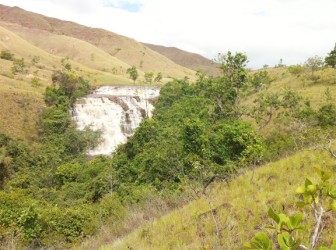The European Union has agreed to fund the construction of a small hydropower station on the Chiung River at Kato in Region Eight.
The total cost of the project is pegged at 2,455,797 euros (approximately $615 million) with the EU contributing 1,841,848 euros (approximately $460 million) under the 10th European Development Fund (EDF) while the Guyana Government will contribute 613,949 euros (approximately $154 million), the EU Delegation in Guyana announced in a press statement yesterday. The construction phase is expected to begin in February 2013 and be completed by February 2015.
The statement said the financing agreement for the Micro-Hydropower System has since been dispatched by the EU Delegation in Guyana to the Minister of Finance who acts as the National Authorising Officer (NAO) for the EU funded programmes in Guyana. A public signing ceremony to officially launch the project is expected to follow in the very near future between the NAO and the Head of Delegation of the European Union in Guyana, the statement said.

The EU said that as part of the government’s broader hinterland electrification programme, the system will comprise a 330-kilowatt micro-hydropower station with its primary energy source being the 36 metres head waterfall in the Chiung River in the vicinity of Kato village. “Sufficient generating capacity for electrical services is to be provided to a secondary school complex to be constructed by the Ministry of Education, existing government buildings such as the nursery/primary schools, the guest house, the police outpost, medical facilities, school dormitories and to also facilitate agro processing and commercial farming. Furthermore the system will provide electricity to Paramakatoi through a 16 km transmission line which forms part of the intervention,” the statement said.
It added that it is expected that the government will fast track the construction of the secondary school facility, which is a pre-condition for the investment to be made. “The secondary school is foreseen to be the main electricity consumer and therefore as such forms the basis for feasibility of the investment,” the statement explained.
According to the release, the Head of Delegation of the European Union in Guyana, Ambassador Robert Kopecký remarked that he “anticipates the speedy commencement of the construction phase of the system and hopes that the construction deadlines can be achieved without any major hiccups.” He further emphasised that the project embodies initiatives under the Low Carbon Development Strategy, while expressing hope that similar sustainable energy uses could be employed especially for the hinterland regions.
The government has been pursuing a mini-hydropower facility for the area for some time with particular emphasis on the potential for expanding crop production. In October 2009, the National Agricultural and Extension Institute (NAREI) in collaboration with the Office of the Prime Minister under the Unserved Areas Rural Electrification Programme had commissioned a ‘Report on Soil and Land Use Surveys to Support the Implementation of an Irrigation System for Agricultural Crop Production in Kato, West-Central Rupununi, Guyana’.
The main task was to establish a rationale for irrigation support to crop production activities in Kato. The principal objective was to determine the economic viability of developing a hydropower facility, to supply energy primarily for irrigating proposed farm lands, the suitability of community lands for agricultural crop production and the possible level of farming for this community.
The main constraint identified by the study was water availability. “The proposal to expand crop lands at Kato is constrained by the absence of an accessible irrigation system. However, the use of energy derived from the proposed development of small hydropower facility will remove this constraint. Pumping water from shallow wells or distributing water from river sources requires energy, which if available, will enhance the irrigation of crop lands at Kato. Also, its implementation will ensure optimal, sustainable, and all year round crop production, providing a reliable and accessible food supply link for neighbouring villages,” it had said.
The report had said that the presence of the all year round flowing Chiung River has the capability through hydropower to provide power for irrigation in crop production systems. If implemented, the suitability of these sites will be upgraded to highly suitable, it said.
“Programmes to introduce new crops to this area should not ignore the acidic nature of these soils (low pH values). Thus, preference should be given to acid tolerant species during crop selection. It must be noted, that these recommendations are only valid with the implementation of a reliable system of irrigation. It is, therefore, recommended that the development of a small hydropower to supply energy for irrigating farm land is diligently pursued,” the study had said.





